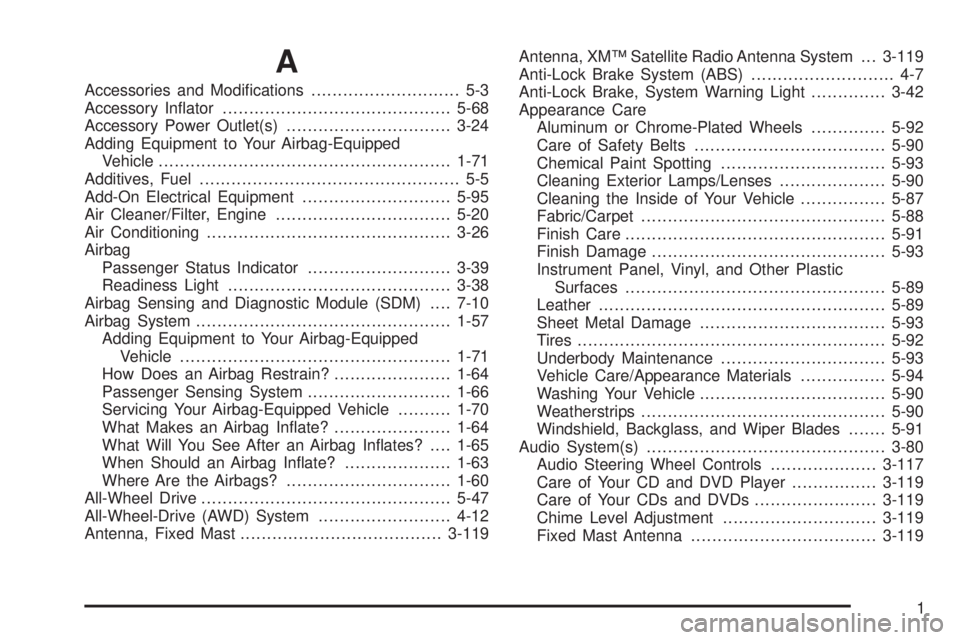2006 BUICK TERRAZA steering wheel adjustment
[x] Cancel search: steering wheel adjustmentPage 140 of 454

Anti-Lock Brake System Warning Light.............3-42
Traction Control System (TCS) Warning Light . . .3-43
Engine Coolant Temperature Gage..................3-43
Malfunction Indicator Lamp.............................3-44
Oil Pressure Light.........................................3-46
Security Light...............................................3-47
Cruise Control Light......................................3-47
Highbeam On Light.......................................3-48
Fuel Gage...................................................3-48
Low Fuel Warning Light.................................3-48
Driver Information Center (DIC).......................3-49
DIC Operation and Displays...........................3-50
DIC Warnings and Messages.........................3-56
DIC Vehicle Personalization
(Uplevel Only)...........................................3-72Audio System(s).............................................3-80
Setting the Time...........................................3-81
Radio with CD..............................................3-82
Navigation/Radio System..............................3-101
Rear Seat Entertainment System...................3-101
Rear Seat Audio (RSA)................................3-115
Theft-Deterrent Feature................................3-117
Audio Steering Wheel Controls......................3-117
Radio Reception.........................................3-118
Care of Your CDs and DVDs........................3-119
Care of the CD and DVD Player...................3-119
Fixed Mast Antenna....................................3-119
XM™ Satellite Radio Antenna System............3-119
Chime Level Adjustment...............................3-119
Section 3 Instrument Panel
3-2
Page 143 of 454

The main components of the instrument panel are the following:
A. Air Outlets. SeeOutlet Adjustment on page 3-29.
B. Turn Signal/Multifunction Lever. SeeTurn
Signal/Multifunction Lever on page 3-7.
C. Audio Steering Wheel Controls (If Equipped). See
Audio Steering Wheel Controls on page 3-117.
D. Instrument Panel Cluster. SeeInstrument Panel
Cluster on page 3-35.
E. DIC Controls (If Equipped). SeeDriver Information
Center (DIC) on page 3-49.
F. Traction Control System Button. SeeTraction
Control System (TCS) on page 4-9.
G. Hazard Warning Flasher Switch. SeeHazard
Warning Flashers on page 3-6.
H. Passenger Airbag Status Indicator and Passenger
Safety Belt Reminder Light. SeePassenger
Airbag Status Indicator on page 3-39
andPassenger Safety Belt Reminder Light on
page 3-37.I. Audio System. SeeAudio System(s) on page 3-80.
J. Exterior Lamps Control. SeeExterior Lamps on
page 3-15.
K. Interior Lamps Control. SeeInterior Lamps Control
on page 3-18. Instrument Panel Brightness Control.
SeeInstrument Panel Brightness on page 3-17.
L. Hood Release. SeeHood Release on page 5-11.
M. Parking Brake. SeeParking Brake on page 2-39.
N. Horn. SeeHorn on page 3-6.
O. Cruise Controls (If Equipped). SeeCruise Control on
page 3-11.
P. Climate Controls. SeeDual Climate Control System
on page 3-26.
Q. Heated Seat Controls (If Equipped). SeeHeated
Seats on page 1-3.
R. Glove Box. SeeGlove Box on page 2-51.
3-5
Page 304 of 454

Before you start, check all trailer hitch parts and
attachments, safety chains, electrical connector, lamps,
tires, and mirror adjustment. If the trailer has electric
brakes, start your vehicle and trailer moving and
then apply the trailer brake controller by hand to be sure
the brakes are working. This lets you check your
electrical connection at the same time.
During your trip, check occasionally to be sure that the
load is secure, and that the lamps and any trailer
brakes are still working.
Following Distance
Stay at least twice as far behind the vehicle ahead as
you would when driving your vehicle without a trailer.
This can help you avoid situations that require
heavy braking and sudden turns.
Passing
You will need more passing distance up ahead when
you are towing a trailer. And, because you are a
good deal longer, you will need to go much farther
beyond the passed vehicle before you can return to
your lane.
Backing Up
Hold the bottom of the steering wheel with one hand.
Then, to move the trailer to the left, just move that hand
to the left. To move the trailer to the right, move your
hand to the right. Always back up slowly and, if possible,
have someone guide you.
Making Turns
Notice:Making very sharp turns while trailering
could cause the trailer to come in contact with the
vehicle. Your vehicle could be damaged. Avoid
making very sharp turns while trailering.
When you are turning with a trailer, make wider turns
than normal. Do this so your trailer will not strike
soft shoulders, curbs, road signs, trees, or other objects.
Avoid jerky or sudden maneuvers. Signal well in
advance.
4-46
Page 441 of 454

A
Accessories and Modi�cations............................ 5-3
Accessory In�ator...........................................5-68
Accessory Power Outlet(s)...............................3-24
Adding Equipment to Your Airbag-Equipped
Vehicle.......................................................1-71
Additives, Fuel................................................. 5-5
Add-On Electrical Equipment............................5-95
Air Cleaner/Filter, Engine.................................5-20
Air Conditioning..............................................3-26
Airbag
Passenger Status Indicator...........................3-39
Readiness Light..........................................3-38
Airbag Sensing and Diagnostic Module (SDM)....7-10
Airbag System................................................1-57
Adding Equipment to Your Airbag-Equipped
Vehicle...................................................1-71
How Does an Airbag Restrain?......................1-64
Passenger Sensing System...........................1-66
Servicing Your Airbag-Equipped Vehicle..........1-70
What Makes an Airbag In�ate?......................1-64
What Will You See After an Airbag In�ates?....1-65
When Should an Airbag In�ate?....................1-63
Where Are the Airbags?...............................1-60
All-Wheel Drive...............................................5-47
All-Wheel-Drive (AWD) System.........................4-12
Antenna, Fixed Mast......................................3-119Antenna, XM™ Satellite Radio Antenna System . . . 3-119
Anti-Lock Brake System (ABS)........................... 4-7
Anti-Lock Brake, System Warning Light..............3-42
Appearance Care
Aluminum or Chrome-Plated Wheels..............5-92
Care of Safety Belts....................................5-90
Chemical Paint Spotting...............................5-93
Cleaning Exterior Lamps/Lenses....................5-90
Cleaning the Inside of Your Vehicle................5-87
Fabric/Carpet..............................................5-88
Finish Care.................................................5-91
Finish Damage............................................5-93
Instrument Panel, Vinyl, and Other Plastic
Surfaces.................................................5-89
Leather......................................................5-89
Sheet Metal Damage...................................5-93
Tires..........................................................5-92
Underbody Maintenance...............................5-93
Vehicle Care/Appearance Materials................5-94
Washing Your Vehicle...................................5-90
Weatherstrips..............................................5-90
Windshield, Backglass, and Wiper Blades.......5-91
Audio System(s).............................................3-80
Audio Steering Wheel Controls....................3-117
Care of Your CD and DVD Player................3-119
Care of Your CDs and DVDs.......................3-119
Chime Level Adjustment.............................3-119
Fixed Mast Antenna...................................3-119
1